Following are excerpts from remarks offered on 20 March 2018 at the Opening Reception for the Exhibition of Paintings for Happiness at the United Nations.
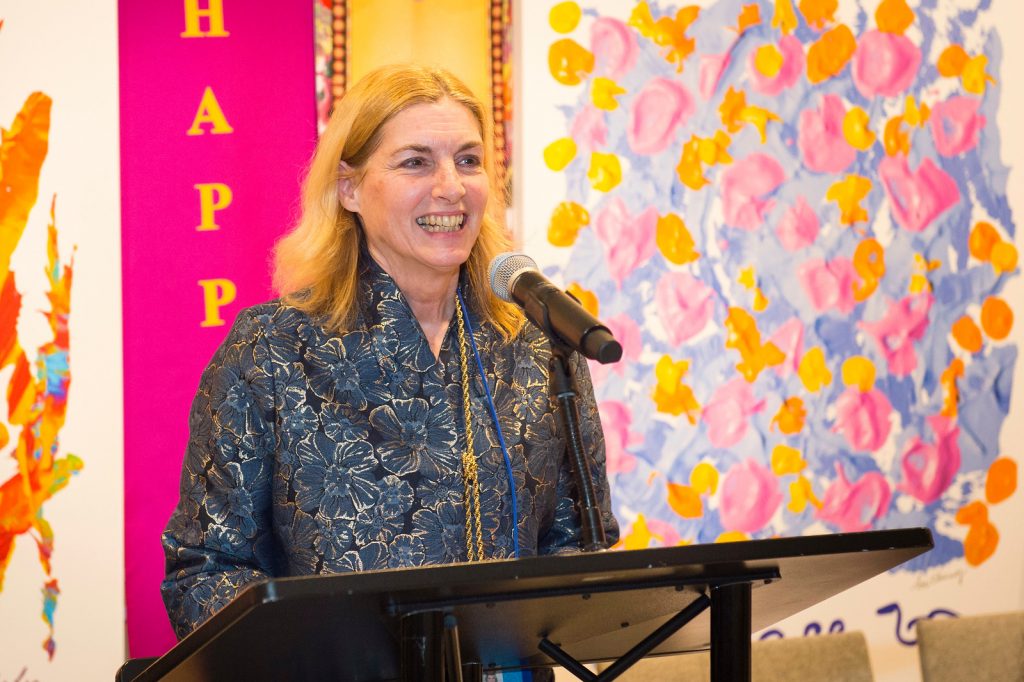
Ms. Nilima Silver, Master of Ceremonies and General Secretary, Sri Chinmoy: The Peace Meditation at the United Nations: Good evening. My name is Nilima Silver, and I would like to welcome you this evening to the Opening of the “Exhibition of Paintings for Happiness,” which is kindly sponsored by the Permanent Mission of the Kingdom of Bhutan to the United Nations, in cooperation with the Jharna-Kala Art Foundation and the Sri Chinmoy Centre. The exhibit is in honour of the “International Day of Happiness,” a UN initiative inspired by the King of Bhutan, in which the UN General Assembly declared 20 March as the International Day.
We are honoured that Secretary-General Guterres has kindly conveyed his best wishes for the success of this event. This day’s theme is surely a welcome one in today’s world, and we are glad that you could join us tonight for this refreshing moment of art. As you can see, the large canvasses on the wall are by renowned artist Sri Chinmoy, and we also have on view hundreds of the “Kids to Kids” happiness paintings from children around the world, displayed on several screens and in portfolio books as well. We are very grateful to Her Excellency Ambassador Doma Tshering, Permanent Representative of the Kingdom of Bhutan to the United Nations, for her generosity and support in sponsoring this Exhibit. And we are especially grateful to Ms. Tshoki Choden for all her efforts on behalf of the Bhutan Mission to bring this exhibit to fruition. Now it is my honour to introduce Mr. Karma Sonam Tshosarm, Deputy Permanent Representative of the Kingdom of Bhutan to the United Nations, who will offer welcoming remarks.
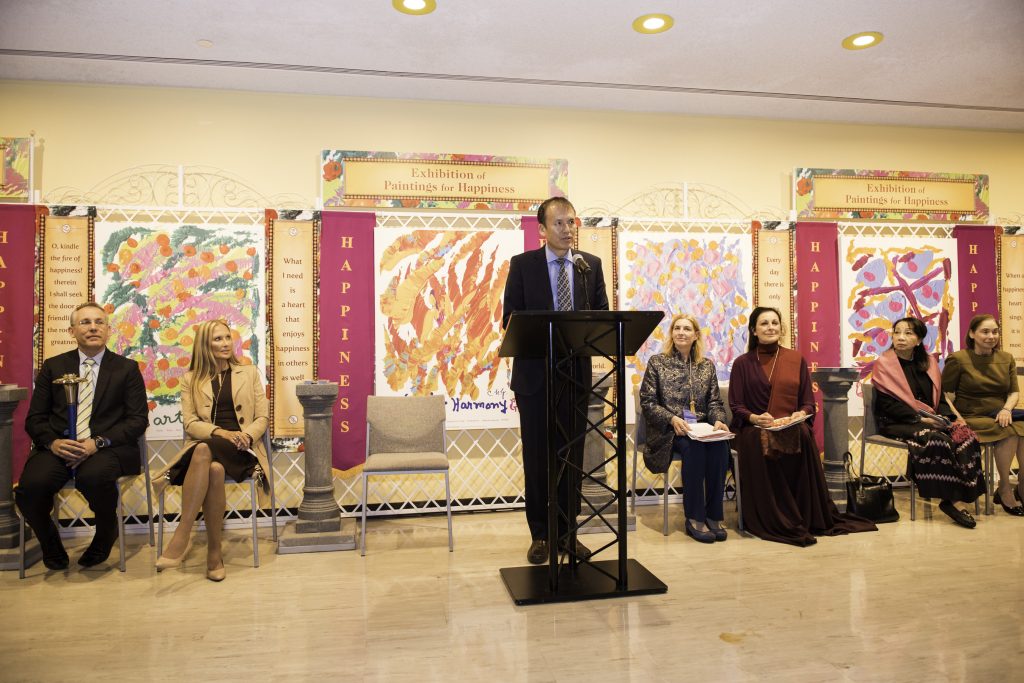
2018-03-20_Paintings-for-Happiness: Mr. Karma Sonam Tshosarm, Deputy Permanent Representative of the Kingdom of Bhutan to the United Nations:
Mr. Karma Sonam Tshosarm, Deputy Permanent Representative of the Kingdom of Bhutan to the United Nations: Excellencies, ladies and gentlemen, good evening to you all. At the outset, I would like to apologize on behalf of my Ambassador, who could not be here at this very important occasion. I, on behalf of my Ambassador, would like to extend a warm welcome to everyone to the Art Exhibition display, “Paintings for Happiness,” which the Permanent Mission of the Kingdom of Bhutan to the United Nations is pleased to co-host with the Jharna-Kala Art Foundation and Sri Chinmoy Centre on this special occasion of the International Day of Happiness.
On 19 July 2011 the international community for the first time recognized happiness as a fundamental human goal with the adoption of the UN General Assembly of resolution 65/309 entitled “Happiness: towards a holistic approach to development.” The resolution called for a holistic approach to economic growth that promotes the happiness and wellbeing of all peoples. Less than a year later, on 28 June 2012, the UN General Assembly adopted another resolution 66/281 declaring 20 March as the International Day of Happiness.
Seven years on, and it is extremely gratifying for Bhutan, as the main force behind the initiative, that the concept of happiness has resonated with many around the globe, as demonstrated by your presence here this evening. We hope that artworks by the “Kids to Kids” project and Sri Chinmoy that are on display today will serve to build bridges in our common quest for a more holistic approach to an inclusive, equitable and balanced approach to economic growth that promotes sustainable development, poverty eradication, happiness and wellbeing of all peoples.
The visual ascetics of happiness demonstrated through paintings such as the ones exhibited today is one way to achieve our common objective. For centuries art has served has a powerful medium of communication. It breaks down barriers and allows us to understand each other, both emotionally and physically. Expression of culture through art, therefore, has become ever more relevant in today’s age of significant cultural and ethnic diversity.
We were happy to receive in Bhutan the “Kids to Kids” project initiative by the Sri Chinmoy Centre through exhibitions in various schools in Bhutan last month. It has heartening to see the children from Bhutan and Japan through their artworks were able to overcome language and physical barriers to connect, communicate and share the love.
As we speak here today national celebrations are underway in Bhutan to observe this important day. On this note, I end here by thanking the Sri Chinmoy Centre for the commendable role in putting up the exhibit, and I would like to thank everyone once again for your presence this evening. I wish you all happiness. Thank you and Tashidelek!
Ms. Nilima Silver, Master of Ceremonies: As the Deputy Permanent Representative said, we are enjoying this very peaceful atmosphere of this Exhibit, and receiving much joy from the canvasses of Sri Chinmoy, displayed on the curved wall, as well as from the children’s art on view. And for this beautiful display, we have to thank the Curator, Ms. Ranjana K. Ghose, who is the Director of the Jharna-Kala Art Foundation. Ranjana has set up many exhibits over the years at the UN, creating spaces of beauty and harmony, and she is going to offer some insights into Sri Chinmoy’s art.
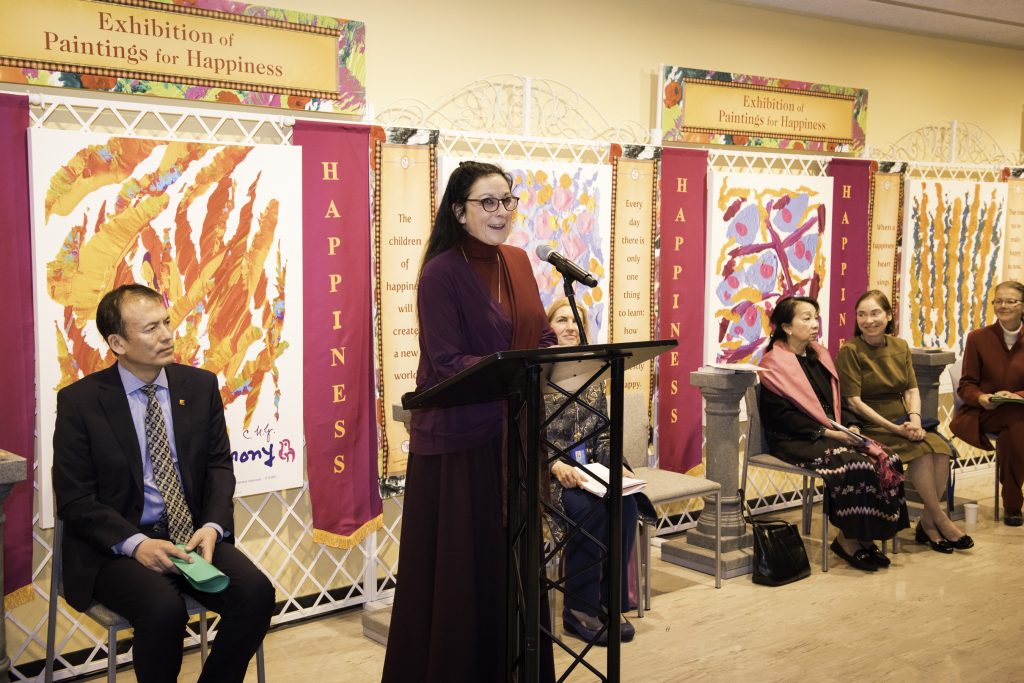
Ms. Ranjana Ghose, Curator of the Exhibit and Director, Jharna-Kala Art Foundation: Good evening and thank you for coming once again to an art exhibition by Sri Chinmoy, but this time with the theme of happiness, which is so appropriate for the first day of Spring here in New York. We’re all very glad that we can get together and share that type of warmth and create the warmth that the world needs in a positive way.
The Exhibition of Paintings for Happiness you will see is a mixed media exhibition, and you will see the installations of slide shows and pictures of the children that participated, and the paintings from the children that are in albums on these shelvings, so that you can look through them. There were hundreds and hundreds and hundreds of paintings. We had to limit it to just a few hundred, but we hope you enjoy it nonetheless.
Here you will notice we have these large canvas repros of art by Sri Chinmoy. These art pieces are each inscribed with a title. We think that the artist really felt that art should be a vehicle to take us someplace higher, someplace deeper, so he inscribed these paintings, I think, with a hint to us of what we really should be thinking of or could be thinking of in a more elevating way. We really particularly like these paintings that have these inscriptions on them. And so many of them, you will find, are qualities that make us a better human being, and I think that makes us happy. I think when we can share our goodness with others, that spreads the happiness, and that is the theme of today’s show.
The Exhibition of Paintings for Happiness on display here are: “Happiness, Compassion, Tolerance, Forgiveness, Grace, Meditation, Earth, Mother Nature, Dream, World-Harmony.” These are some of the titles that Sri Chinmoy gave us, and I think it was an aid to concentrate on the good qualities within ourselves and the good qualities of those around us, and those qualities which we hope will develop in society. In fact, we see that several of the Sri Chinmoy paintings are titled “World-Harmony.” This theme is apparently very important to the artist Sri Chinmoy.
The artist speaks through his art, and it is apparent that these paintings have a message and a prayer for a more illumined humanity. These paintings for happiness, these paintings for peace, these paintings for world harmony are by artist Sri Chinmoy, as you know, and his signature “CKG” Peace-Birds have been an artistic endorsement for world peace for decades. Sri Chinmoy’s art embodies the messages of world peace, harmony, happiness and an aspiration for a more concerned society. In using this genre to help culture peace and happiness in the self and in the world, Sri Chinmoy created Peace-Bird drawings and paintings with inspiring dedications, surely in hopes of kindling an awareness and strengthening a progress towards that concern in fellow world citizens.
“Why Peace through Art?” you might ask. Well, what greater and more appropriate role could art play! Art itself, like humanity, thrives best in a climate of peace. And art, like humanity and like children of humanity, perishes as a result of war and intolerance. As art is a child of our heart that must be nurtured, nourished and cared for, humanity must also be nourished, nurtured and cared for as a child of our very own heart. The world is crying to each one of us for help. These paintings are as though an affirmation of faith in our own humanity. May they serve as a reminder in the middle of a stressful day or perhaps a profound epiphany at twilight as to who we are and as to who we might truly become.
I do hope you enjoy the Paintings for Happiness Exhibit. The art is visually nourishing and supplies us with food for thought. The Jharna-Kala Art Foundation is grateful to the Permanent Mission of the Kingdom of Bhutan to the United Nations for sponsoring this Exhibit, and we are also happy to partner with the “Kids to Kids” paintings for happiness project.
Our esteemed Ambassador Chowdhury, in his official capacity as Under-Secretary-General of the UN, was designated to champion the cause of the General Assembly’s Culture of Peace, and then again in 2012 he ushered in the GA resolution for the International Day of Happiness, drafting it on behalf of the then President of the General Assembly. We are quite aware that this initiative was directly inspired by the King of Bhutan’s wisdom for the GNH, the Gross National Happiness. So good things build upon other good things, and in so many ways His Excellency has been intrinsically elemental in this world-inspiring issue.
We as an Art Foundation also feel strongly that if art can be a tool for cultivating a happier and healthier society, then let us encourage and let us create and let us partake. Thank you for coming.
Nilima Silver, Master of Ceremonies: We are very fortunate to have with us tonight Daw Aye Aye Thant, the daughter U Thant, the third United Nations Secretary-General, and President of the U Thant Institute. As you may know, at the invitation of Secretary-General U Thant, in 1970 Sri Chinmoy began leading meditations for delegates and staff at UN Headquarters here in New York. Until his passing in 2007, Sri Chinmoy offered his multifaceted inspiration to the UN community, through these meditations, lectures, concerts, art exhibits and other programmes for peace, and this exhibit follows in this tradition. Aye Aye is a very dear friend, and she has kindly brought a drawing by her granddaughter to contribute to this Exhibit. We would be honoured if she could say a few words.
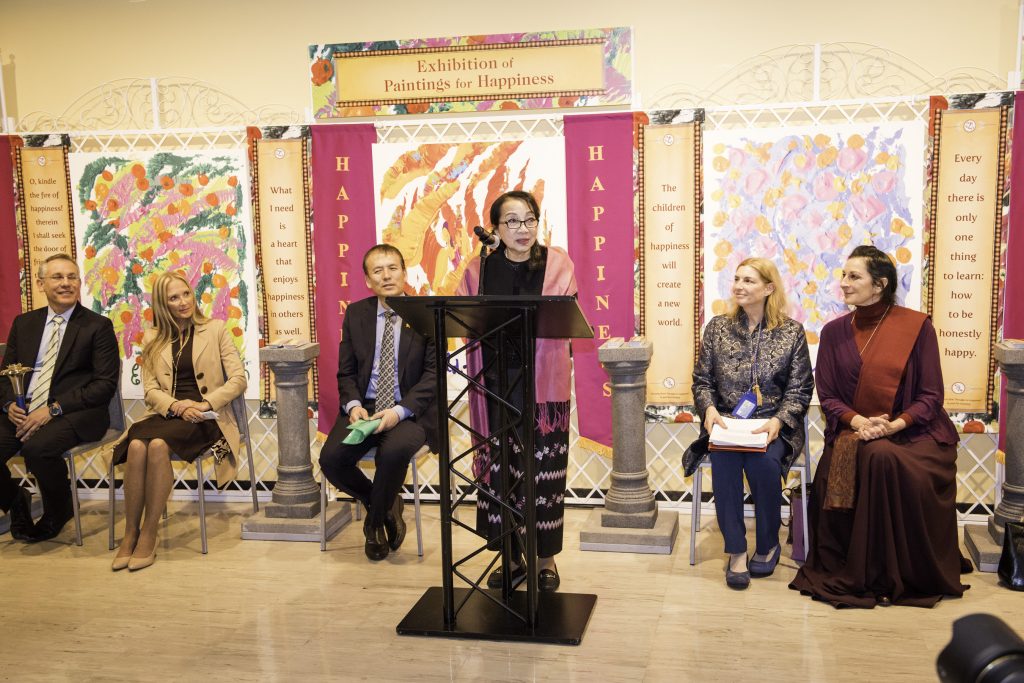
Daw Aye Aye Thant, the daughter U Thant, the third United Nations Secretary-General, and President of the U Thant Institute: Excellencies, honoured guests and friends, I’m very honoured to have this opportunity to be here today and give my warmest greetings for happiness. I’m really honoured to have this opportunity to join you on this auspicious day, the International Day of Happiness.
It is also my great pleasure that I could share a painting by my granddaughter Nora Amaya Palkon, for the “Kids to Kids” happiness paintings exhibition in honour of the International Day of Happiness. I was asked whether she would be able to contribute the painting, and she said, “Sure,” and I was actually quite surprised that she said it so willingly. So this is her picture [applause]. She just turned 14 last Wednesday, so I’m quite proud of it, as you can see.
I’m also happy that I could be with you today and have the honour of meeting more new friends and seeing so many friends. I would like to take this opportunity to express my appreciation for the endeavour to Ranjana for the art to promote awareness of the sustainable goals that the UN has launched to advance the wellbeing and happiness of human lives around the globe. And I’m especially grateful that you have included “Kids to Kids” happiness paintings inspired by Sri Chinmoy’s statement that “The children of happiness will create a new world.”
As my father once said, “The youth of today are the takeover generation and we, the older generation, must give must more attention to the huge task of preparing the young for life.” He said, and I quote, “I have very high hopes for the younger generation. In my view the young men and women of today are showing a good deal of initiative, imagination and independence of thought, which are very important in these tense times.” He also pointed out that “Perhaps the most important thing we can say to the young today is that emotions that move them – the hatred of war, the thrust for equality of opportunity, the passion for building a more equitable society, the cry for tolerance and justice – are the very foundation upon which the United Nations was built.” He added, “We who served in this family of organizations should therefore look to the newly vocal young as our allies.”
We all here also believe that those are the key aspects that could lead to human wellbeing and happiness. How could we find happiness? A man asked Lord Buddha, “I want happiness.” Lord Buddha said, “First, remove ‘I’, that’s ego. Then remove want, that’s desire. See? Now you are left with only happiness.” May the future generation find a way to live a life with a sense of purpose, a life with lasting fulfilment and contentment, and experience a greater level of happiness in their lives.
I would like to conclude by quoting Sri Chinmoy, “Wherever you go, carry happiness with you.” May I now present the painting to the Exhibit [presents painting to Ms. Ranjana Ghose]. Thank you.
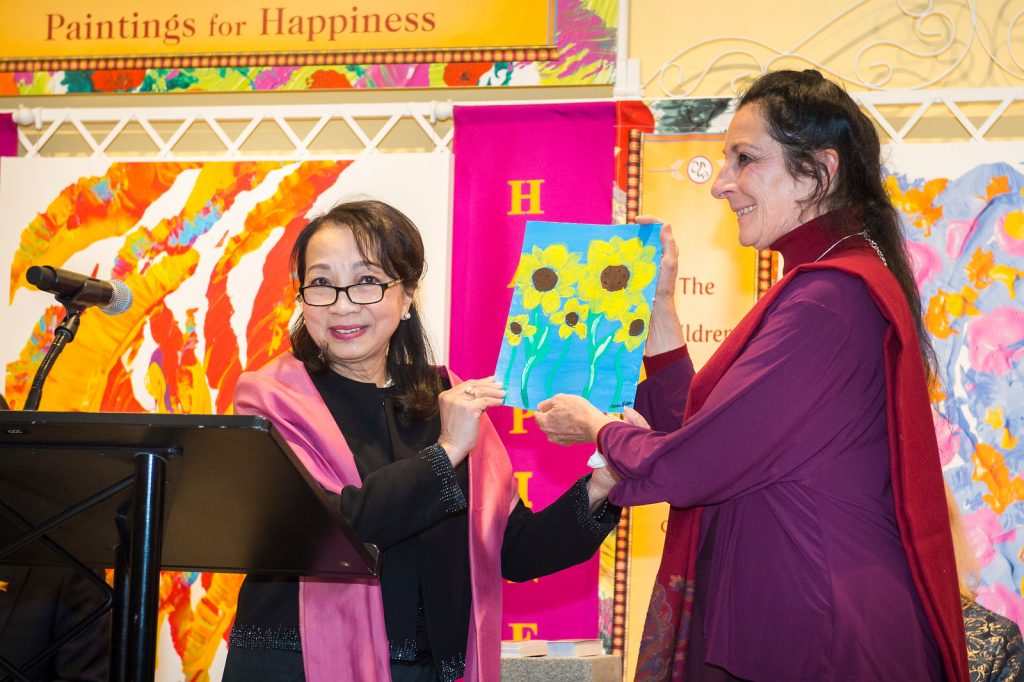
Ms. Ranjana Ghose, Curator of the Exhibit and Director, Jharna-Kala Art Foundation: I would just like to add something about the significance of Aye Aye’s presence in our ceremony today. As you know, she is the very fine daughter of U Thant. She has accompanied him on so many occasions, and was behind him all the way, always for her father’s wellbeing, and taking care of him. It turns out that this particular UN Peace Bell was actually presented to U Thant during U Thant’s administration by the maker, who was a Japanese man. And still it is rung twice a year, and today is also one of those days that it is rung. It is only rung on the International Day of Peace, which is in September, and today, which is the Spring Equinox. So we feel that it is especially auspicious that Aye Aye is here to once again witness the Peace Bell on this day.
And we are so glad that she continues her work for peace throughout the world. She and her husband, Tyn, founded the U Thant Institute that encourages humanitarian type projects, projects that helped culturally and mentally in Myanmar, once the doors were opened up once again. She has been working to inspire people in New England tremendously through her Association. Whenever she comes into a room, people feel more inspired, and that is part of the special blessing of her life, I think, that she brings with her to everybody. So we thank you for this beautiful painting from your granddaughter.
Ms. Nilima Silver, Master of Ceremonies: Next I would like to invite Ms. Kritagyata Nicholls, the Coordinator of “Kids to Kids International.” One of their primary activities has been to promote the International Day of Happiness in schools around the world. In this regard, Kritagyata has collected hundreds and hundreds of sweet drawings, many of which have been shared with the children of Bhutan, and she will now give us some background on these activities.
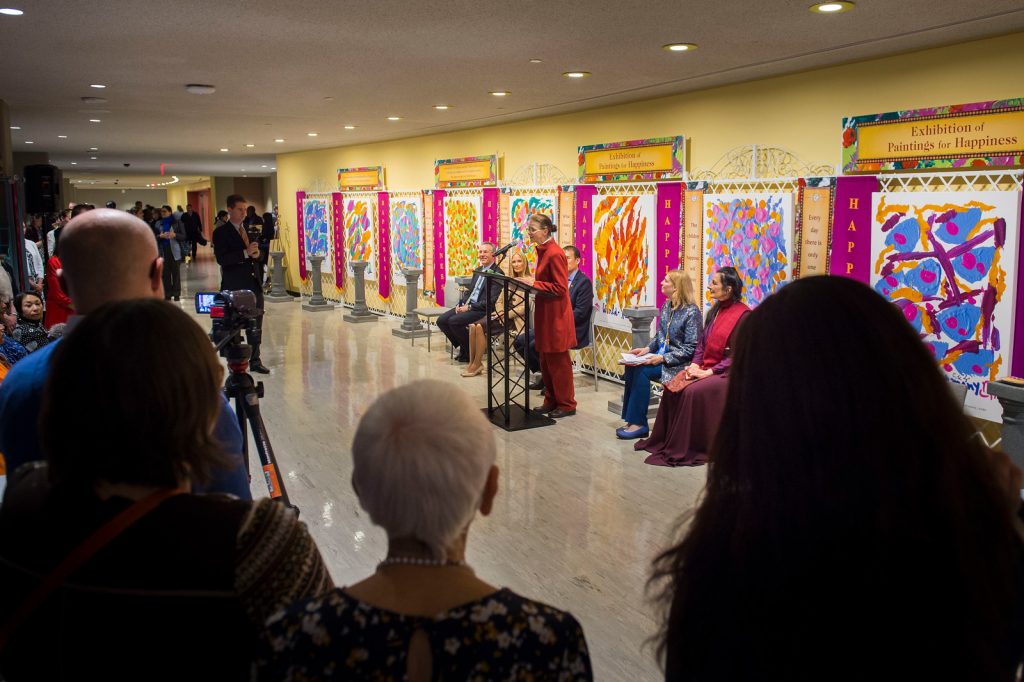
Ms. Kritagyata Nicholls, Coordinator of “Kids to Kids International”: “Kids to Kids International” is a programme of The Oneness-Heart-Tears and Smiles Humanitarian Service, which was initiated by Sri Chinmoy in 1991. Participating in the Kids to Kids programme provides schoolchildren around the world with the opportunity to reach out, connect and support their peers in other countries. We send “Kids to Kids Kits”, which the children prepare in a little 12×12 ziplock bag. They add school supplies, hygienic goods, and they create something personal as well, either a poem or a drawing, and sometimes they add one of their toys. This project has enabled thousands of children worldwide to send their goodwill and foster friendship with children in other countries with very different cultures and backgrounds, helping them all to grow into caring, globally minded adults.
Inspired by the deep significance of the Bhutanese education for happiness, one of our primary activities since 2013 has been to promote the International Day of Happiness in schools. We actually enter the schools, and we have a team of educators who teach and speak about the Bhutanese legacy and the efforts of the Kings of Bhutan to spread the message of happiness throughout the world.
In 2017, we decided to further this project by creating an international art project. It’s on the theme of happiness, and children here have contributed from 27 nations. They have made their own artwork on the theme of happiness as a gratitude gift to the Kingdom of Bhutan. Teachers have told us that the children who participated in the project felt very empowered and they wanted to do more for the world. They said also that they noticed it brought forward in these children their own higher qualities.
Two professors on our team, one of which is here, Dr. St-Amand of Ottawa University, traveled to Bhutan just a few weeks ago. He delivered 300 of the children’s drawings to Bhutan with another professor from Japan, Dr. Sunaoshi of Kyoto Seika University, and they visited 7 schools. They spoke in the schools, and they mounted four of the children’s art exhibits, and that included primary schools, high schools and the Royal Bhutan University. They have found in their expression and their experiences with educators, policy makers and students, they experienced the open-hearted kindness of the Bhutanese people, enabling them to learn a great deal about Bhutan’s commitment to and everyday practice of promoting and ensuring happiness.
It is our fervent hope that the current project and visits are but the beginning of our very special friendship and partnership with schools and educators in Bhutan. Thank you.
Ms. Nilima Silver, Master of Ceremonies: Our next speaker, Mrs. Cathy Oerter is the Chair of the Board of Directors of the Art of the Olympians, but most importantly a very dear friend. She was married to the legendary Olympian discus thrower Al Oerter for 25 years and shared a unique life with this four-time discus gold medalist, who is the only Olympian to win four golds in four successive Olympiads and set Olympic records each time. So they were definitely a power couple! Cathy and Al began in 2005 to promote the ancient Olympic Ideals of body, mind and spirit to educate our children about the value of being at your best in all endeavours with emphasis on the cultural arts. She has generously offered her inspiration and support for this Exhibit, and we are honoured she can offer some remarks now.
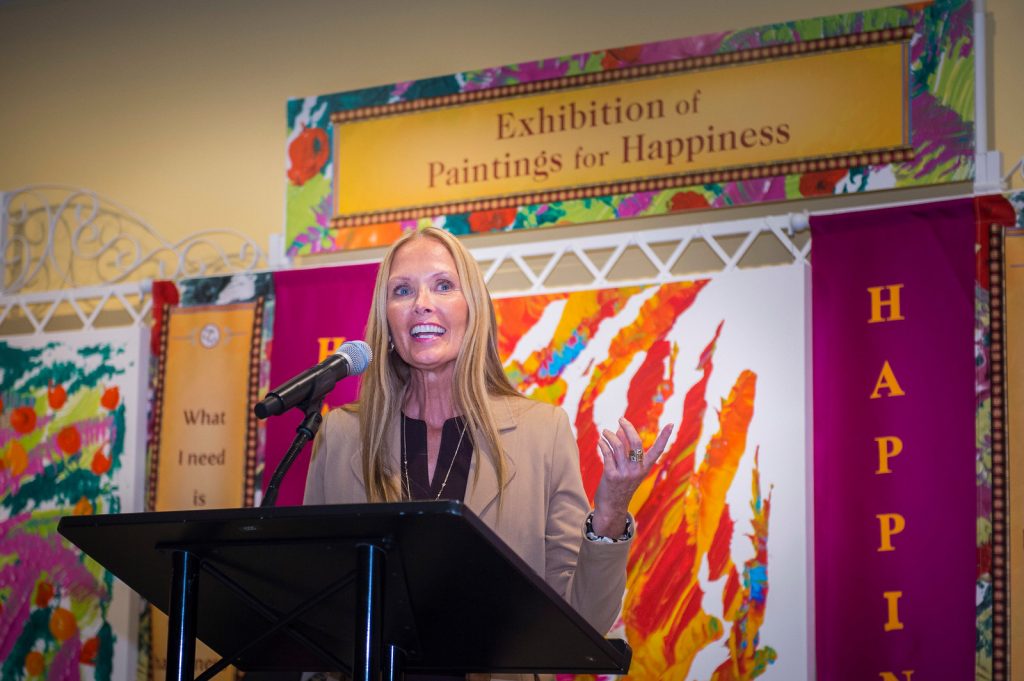
Mrs. Cathy Oerter, Chair of the Board of Directors of Art of the Olympians: I hope you can hear me because I feel like I’m standing in a garden of flowers that are actually singing at the top of their lungs! This display of colour is happiness, and we all have that within us.
I was just at the International World Conference Summit on Happiness, and the big mantra now is “happiness,” thanks to your country, Bhutan. They’ve really started this drive towards happiness.
And something very special about Al, besides being this incredible Olympian, was he gathered these Olympian artists together to share with children: It’s not being the best just in sport, but being the best you can be in life. And he wanted the children to draw pictures, and we have contests, and we work a lot with the Peace Runners – what happiness means to them, what the earth means to them, what peace means to them. It is through those voices of the children that happiness will prevail. We’re there now, the engine’s started, and we’re all on the train.
So thank you all for supporting this event. My blessings to you all.
Ms. Nilima Silver, Master of Ceremonies: Thank you, Cathy. Cathy mentioned the Peace Run, and our next speaker is Mr. Salil Wilson, who is the Executive Director of the Sri Chinmoy Oneness-Home Peace Run. If there is anything that promotes happiness and education, it is the Peace Run, as you can see from the charming videos showing here. And the Peace Torch is also available here in the Exhibit, so that guests can hold the Torch and make a wish for Peace. We’d like Salil to give us some background on the Peace Run now.
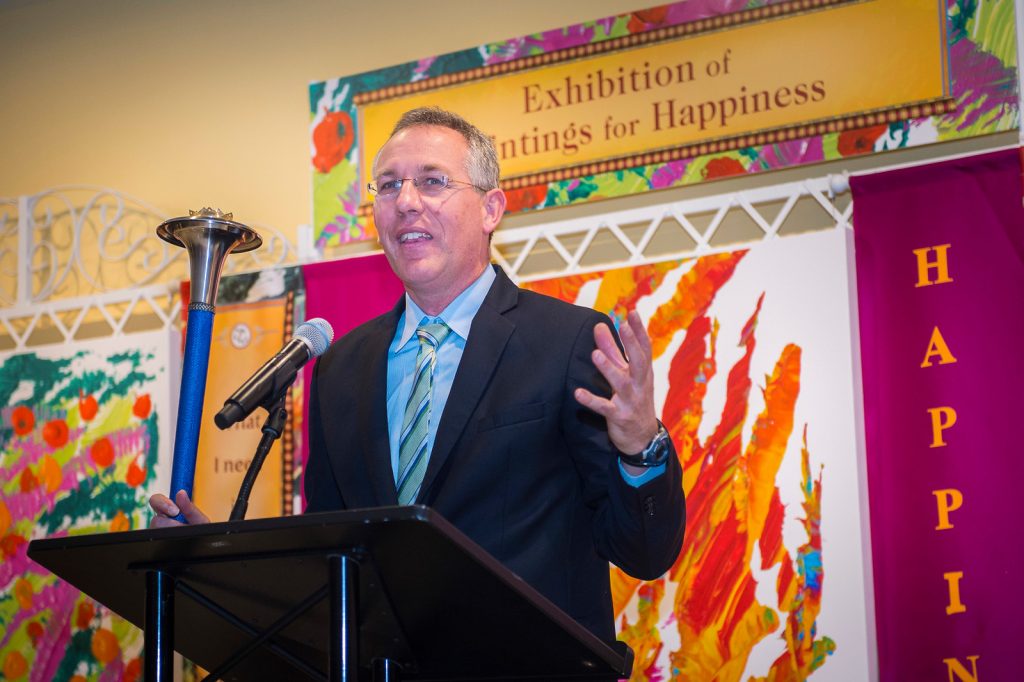
Mr. Salil Wilson, Executive Director, Sri Chinmoy Oneness-Home Peace Run: Distinguished guests, ladies and gentlemen, as I was sitting here waiting for this event to begin, it struck me that the United Nations is where all the prayers, all the hopes, all the dreams for world peace may end up. Every single person around the world wants peace, they want love, they want happiness in their life, and this is the place that represents those hopes and those dreams. So the work that’s being done here by the representatives of the Missions, the international civil service, it’s not just important, but its crucial.
Sri Chinmoy used to refer to the United Nations as the “Heart-Home of the World-Body.” And I can’t think of a more fitting place to have this exhibit than right here in the heart-home of the world. It was in these halls that Sri Chinmoy first said these immortal words. After one of these meditation offerings for delegates and staff, he was leaving, and he said, “Can we not do a worldwide relay run for peace?”
And from that simple statement this remarkable phenomenon has grown, and it’s grown because each person has a love for peace, each person has a hope for peace, each person has a dream for peace. And that’s what connects us all at our deepest level, that’s what makes us human beings. It finds expression in all different ways, in all different mediums, through art, through sport, through poetry. But it’s this yearning for peace, this yearning for happiness, that unites us all.
And so that finds life here today in these beautiful artworks. It finds life here in this torch. It finds life here in the fact that we’ve come together around this need, this yearning. So I want to thank everybody, applaud everybody, for listening to that inner call and responding to it and bringing yourself here to share in this. At this moment, I would like to invite all of our guests to kindly join together and to hold the Peace Torch. [Speakers gather to hold the torch together]
Ms. Nilima Silver, Master of Ceremonies: Again, I want to thank everybody for coming, and especially the Permanent Mission of the Kingdom of Bhutan for so kindly sponsoring this event and making this all possible. Thank you.
